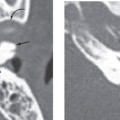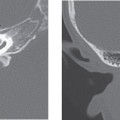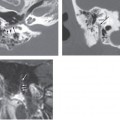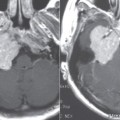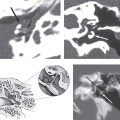CHAPTER 53 Fibrous Dysplasia
Epidemiology
Fibrous dysplasia (FD) is a disease that commonly affects adolescents and young adults. There are two major forms of disease: monostotic FD, which involves a single bone, and polyostotic FD, which involves multiple bones. Monostotic FD is most common in adults younger than 30 years of age (75%); 10% of patients with monostotic FD have temporal bone involvement.
Polyostotic FD affects young children, with the skull and face being more commonly involved (50%). It accounts for 25 to 27% of all FD cases, and involves two or more osseous sites generally on the same side. Most patients present at a young age usually with craniofacial asymmetry. A subtype, McCune-Albright syndrome, is defined by a clinical triad of polyostotic FD, which is usually unilateral, endocrine dysfunction, and café-au-lait spots. This subtype accounts for 3 to 5% of all FD cases and affects more bones more severely at an earlier age. It primarily occurs in females. Fibrous dysplasia (monostotic and polyostotic) is thought to arise from sporadic gene mutation.
Clinical Features
Craniofacial lesions are more frequently polyostotic, and affect the skull and face in 40 to 60% of cases, whereas monostotic FD affects the skull and face in 25%. The most common clinical presentation is conductive hearing loss. Occasionally patients may present with tinnitus, dizziness, pain, trismus, and multiple cranial neuropathies due to involvement of the middle and posterior cranial fossa. Patients may also complain of swelling, pain, and tenderness.
Pathology
Stay updated, free articles. Join our Telegram channel

Full access? Get Clinical Tree


